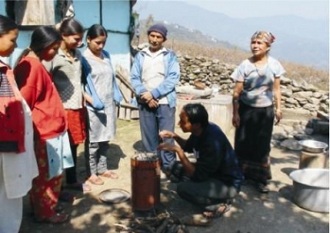Thorax. 2009 Aug;64(8):705-8.
Association between biomass fuel and pulmonary tuberculosis: a nested case-control study.
Kolappan C, Subramani R.
Tuberculosis Research Centre, Mayor V R Ramanathan Road, Chetput, Chennai, India.
kola155@rediffmail.com
OBJECTIVE: To quantify the association between biomass fuel usage and sputum-positive pulmonary tuberculosis.
Methodology: A tuberculosis prevalence survey was conducted in a random sample of 50 rural units (villages) and three urban units in the Tiruvallur district of Tamilnadu, India during the period 2001-2003. Additional data regarding exposure to tobacco smoking, alcohol consumption, biomass fuel usage and Standard of Living Index (SLI) were also collected from the study participants. A nested case-control study was carried out in this population. Cases are defined as bacteriological-positive cases diagnosed by either sputum smear or culture examination. For each case, five age-(within +/-5 years of age) and sex-matched controls were selected randomly from the non-cases residing in the same village/unit. Thus, 255 cases and 1275 controls were included in this study.
RESULTS: The unadjusted OR measured from univariate analysis for biomass fuel is 2.9 (95% CI 1.8 to 4.7). The adjusted OR measured from multivariate analysis using Cox regression is 1.7 (95% CI 1.0 to 2.9). Thirty-six percent of cases are attributable to biomass fuel usage.
CONCLUSION: The findings from this case-control study add to the evidence for an independent association between biomass smoke and pulmonary tuberculosis. Improvement in standards of living brought about by economic development will lead to more people using cleaner fuels for cooking than biomass fuel which in turn will lead to a reduction in the occurrence of pulmonary tuberculosis in the community.



